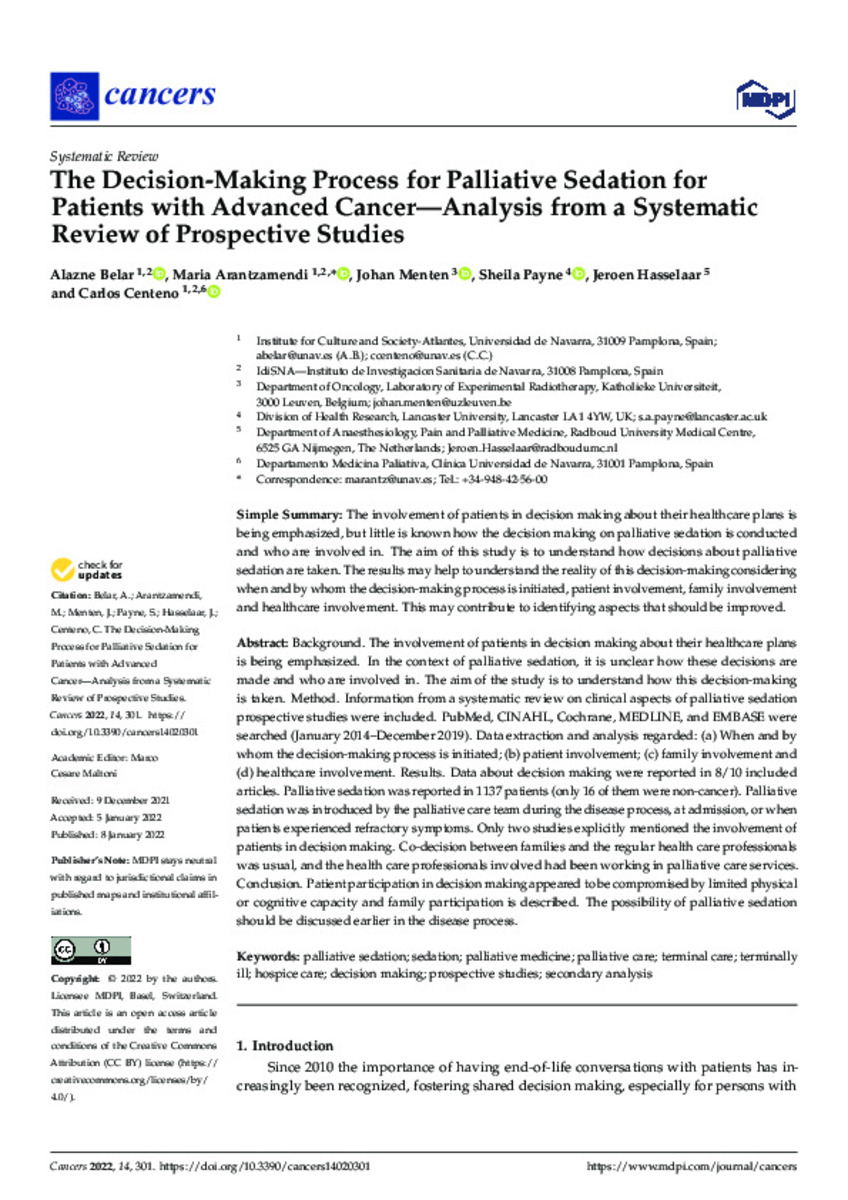Registro completo de metadatos
| Campo DC | Valor | Lengua/Idioma |
|---|---|---|
| dc.creator | Belar, A. (Alazne) | - |
| dc.creator | Arantzamendi-Solabarrieta, M. (María) | - |
| dc.creator | Menten, J. (Johan) | - |
| dc.creator | Payne, S. (Sheila) | - |
| dc.creator | Hasselaar, J. (Jeroen) | - |
| dc.creator | Centeno, C. (Carlos) | - |
| dc.date.accessioned | 2022-02-09T13:51:49Z | - |
| dc.date.available | 2022-02-09T13:51:49Z | - |
| dc.date.issued | 2022 | - |
| dc.identifier.citation | Belar A, Arantzamendi M, Menten J, Payne S, Hasselaar J, Centeno C. The decision-making process for palliative sedation for patients with advanced cancer. Analysis from a systematic review of prospective studies. Cancers. 2022; 14(2):301. | es_ES |
| dc.identifier.issn | 2072-6694 | - |
| dc.identifier.uri | https://hdl.handle.net/10171/62901 | - |
| dc.description.abstract | Background. The involvement of patients in decision making about their healthcare plans is being emphasized. In the context of palliative sedation, it is unclear how these decisions are made and who are involved in. The aim of the study is to understand how this decision-making is taken. Method. Information from a systematic review on clinical aspects of palliative sedation prospective studies were included. PubMed, CINAHL, Cochrane, MEDLINE, and EMBASE were searched (January 2014–December 2019). Data extraction and analysis regarded: (a) When and by whom the decision-making process is initiated; (b) patient involvement; (c) family involvement and (d) healthcare involvement. Results. Data about decision making were reported in 8/10 included articles. Palliative sedation was reported in 1137 patients (only 16 of them were non-cancer). Palliative sedation was introduced by the palliative care team during the disease process, at admission, or when patients experienced refractory symptoms. Only two studies explicitly mentioned the involvement of patients in decision making. Co-decision between families and the regular health care professionals was usual, and the health care professionals involved had been working in palliative care services. Conclusion. Patient participation in decision making appeared to be compromised by limited physical or cognitive capacity and family participation is described. The possibility of palliative sedation should be discussed earlier in the disease process. | es_ES |
| dc.language.iso | eng | es_ES |
| dc.publisher | MDPI | es_ES |
| dc.rights | info:eu-repo/semantics/openAccess | es_ES |
| dc.subject | Palliative sedation | es_ES |
| dc.subject | Sedation | es_ES |
| dc.subject | Palliative medicine | es_ES |
| dc.subject | Palliative care | es_ES |
| dc.subject | Terminal care | es_ES |
| dc.subject | Terminally ill | es_ES |
| dc.subject | Hospice care | es_ES |
| dc.subject | Decision making | es_ES |
| dc.subject | Prospective studies | es_ES |
| dc.subject | Secondary analysis | es_ES |
| dc.title | The decision-making process for palliative sedation for patients with advanced cancer. Analysis from a systematic review of prospective studies | es_ES |
| dc.type | info:eu-repo/semantics/review | es_ES |
| dc.editorial.note | This is an open access article distributed under the Creative Commons Attribution License which permits unrestricted use, distribution, and reproduction in any medium, provided the original work is properly cited | es_ES |
| dc.identifier.doi | 10.3390/cancers14020301 | - |
Ficheros en este ítem:
Estadísticas e impacto
Los ítems de Dadun están protegidos por copyright, con todos los derechos reservados, a menos que se indique lo contrario.






